Trigonometry - 2021
Part of the Oxford MAT Livestream
MAT syllabus
Solution of simple trigonometric equations. The identities
tanx=sinxcosx,sin2x+cos2x=1,sin(90∘−x)=cosx.
Periodicity of sine, cosine and tangent. Sine and cosine rules for triangles.
Revision
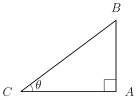
- If triangle ABC is right-angled at A and ∠BCA=θ, then sinθ=|AB||BC|,cosθ=|AC||BC|,tanθ=|AB||AC|.
- So tanθ=sinθcosθ.
- Also, by Pythagoras' Theorem, |AB|2+|AC|2=|BC|2 so sin2θ+cos2θ=1.
- Since the angles in a triangle add up to 180∘, the angle at B is 90∘−θ.
So sin(90∘−θ)=cosθ and cos(90∘−θ)=sinθ. - The sine, cosine, and tangent functions are all periodic; sin(x+360∘)=sinx,cos(x+360∘)=cosx,tan(x+180∘)=tanx.
- Also, we have sin(−x)=−sinx, and cos(−x)=cos(x).
Now consider a triangle that is not necessarily right-angled.
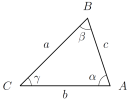
Let's write the angles at A, B, C as α, β, γ respectively, and call the side-lengths a=|BC|, b=|AC|, c=|AB|.
- The area of this triangle is 12absinγ.
- (The cosine rule) We have a2=b2+c2−2bccosα.
- (The sine rule) We have sinαa=sinβb=sinγc.
Warm-up
- Write down the values of sinx and cosx and (where possible) tanx when x is equal to 0∘, 30∘, 45∘, 60∘, 90∘, 120∘, 135∘, 150∘, 180∘, 210∘, 225∘, 240∘, 270∘, 300∘, 315∘, 330∘.
- Find all the solutions to sinx=12 with 0≤x<360∘.
- Find all the solutions to tanx=1 with 0≤x<360∘.
- Find all the solutions to tan(45x)=1 with 0≤x<360∘. [Careful, not just 1∘ and 5∘.]
- Simplify cos4x+2sin2xcos2x+sin4x.
- For 0≤x<90∘, write 1−sin2x+sin4x−sin6x+… as a single expression (not an infinite sum) in terms of cosx. Why have I excluded 90∘ from the range here?
- Write cos4x+cos2x in terms of sinx.
- Simplify cos(450∘−x).
- Simplify cos(90∘−x)sin(180∘−x)−sin(90∘−x)cos(180∘−x).
[If you know a fact about sin(A−B), you may only use it if you prove it!] - A triangle ABC has side lengths AB=3 and BC=2, and the angle ∠ABC=120∘. Find the remaining side length AC, the area of the triangle, and an expression for sin∠BCA.
- Write down three different expressions for the area of triangle ABC, with each expression involving two of the side-lengths and one of the angles. All of these expressions must be equal because they're all equal to the area. Divide each expression by the product of all three side-lengths and multiply by 2. Which rule have you arrived at?
- From the cosine rule, and the fact that −1≤cosα≤1, deduce that for any triangle with side lengths a>b>c>0, we must have a<b+c ("the longest side is shorter than the sum of the other two sides" or said differently "the shortest route from B to C is a straight line" also known as "the triangle inequality").
MAT questions
The minimum value achieved by the function
f(x)=9cos4x−12cos2x+7
equals
(a) 3,
(b) 4,
(c) 5,
(d) 6,
(e) 7.
Hint: you do not need to do any differentiation here!
MAT 2016 Q1D
How many solutions does cosn(x)+cos2n(x)=0 have in the range 0⩽x⩽360∘ for an integer n⩾1?
(a) 1 for all n,
(b) 2 for all n,
(c) 3 for all n,
(d) 2 for even n and 3 for odd n,
(e) 3 for even n and 2 for odd n.
Hint: the second term is the square of the first term.
MAT 2017 Q1F
The picture below shows the unit circle, where each point has coordinates (cos(x),sin(x)) for some x. Which of the marked arcs corresponds to
tan(x)<cos(x)<sin(x) ?
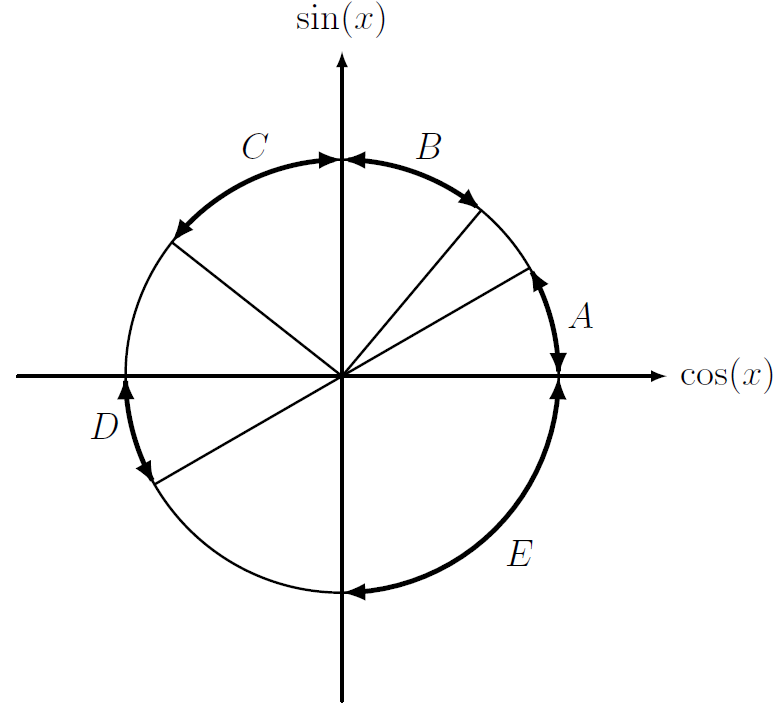
Hint: First, you could think about where sinx=cosx.
MAT 2013 Q4
(i) Let a>0. Sketch the graph of a+xa−xfor−a<x<a.
(ii) Let 0<θ<90∘. In the diagram below is the half-disc given by x2+y2≤1 and y≥0. The shaded region A consists of those points with −cosθ≤x≤sinθ. The region B is the remainder of the half-disc. Find the area of A.
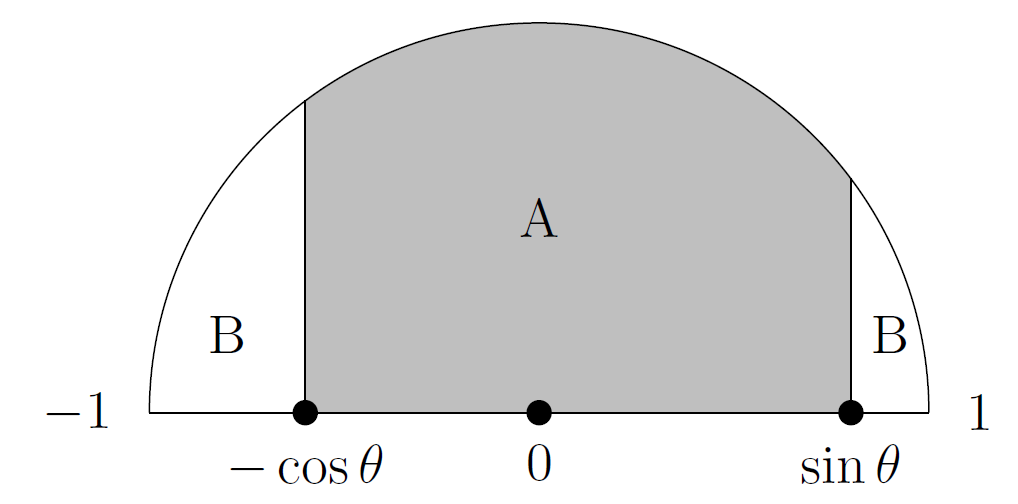
(iii) Assuming only that sin2θ+cos2θ=1, show that sinθcosθ≤1/2.
(iv) What is the largest value that the ratio
area of Aarea of B
can be, as θ varies?
Hints: It's often helpful to draw in the radii when we've got a circle and we have some interesting points on the circumference. We're not actually given any angles in this question, but there is a θ here, so maybe we can find an angle that's θ.
In part (iii) you may also assume that x2≥0 for any real x.
Part (iv) actually relates back to the first part of the question, but perhaps you don't need to spot that in order to realise that you can make that ratio big just by making A big.
Extension
The following material is included for your interest only, and not for MAT preparation.
Later in A-level Maths or equivalent, you will learn that if y=sinx then dydx=cosx, and that if y=cosx then dydx=−sinx. This means that we can draw a nice diagram where arrows represent differentiation, like this;
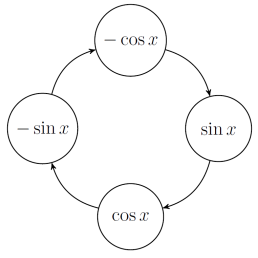
Even better, if you learn about complex numbers in Further Maths A-level or equivalent, then you'll find out about the number i with i2=−1. You already know that the derivative of ekx is kekx, so once you've seen complex numbers like i then you can draw diagrams where arrows represent differentiation, like this;

So is eix equal to sinx? Well no, not quite. It behaves the same way as sinx when we differentiate it, but so does cosx or 3isin(x), so we've got options here. It turns out to be more useful to write eix=cosx+isinx, which agrees with the values of sinx and cosx when x=0 (and, after differentiating, still agrees when x=0). This is known as "Euler's formula", but the English mathematician Roger Cotes knew it about twenty years earlier!

